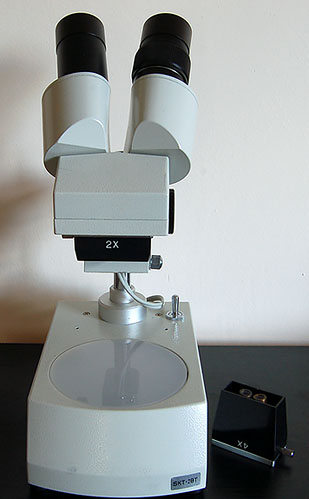
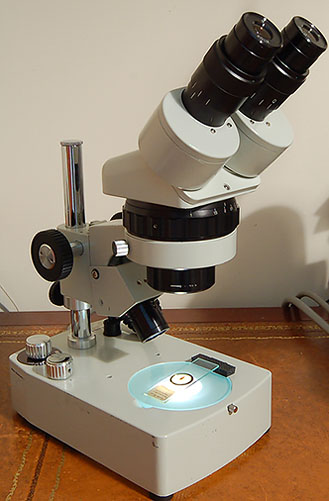
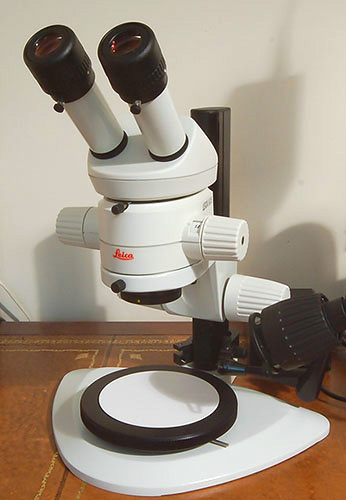
Review: Three stereo microscope models / designs compared
written by David Walker, assessment by David and Ian Walker
Revised Dec. 2011
The author and his brother Ian recently had an opportunity to compare 'hands-on' three designs of stereo microscope that covered the budget - mid - higher price range. These results are compiled below as may be of interest to others. Our own interest stemmed from wishing to upgrade a budget model owned for many years to a better one (in a finite budget!) and wishing to compare the price / performance factor. The price range covered here is ca. £120 to £620 (used from dealer or auction).
I should stress that this was very much a practical assessment from our limited viewpoints as hobbyists who haven't had the opportunity to assess a wide range of similar models from other makers; but suspect this is the sort of perspective which other hobbyists wishing to buy or upgrade a stereo may have.
The three models assessed:



Left:
Meiji SKC-BT - with built in incident and transmitted fixed intensity
low wattage tungsten lighting.
Middle: Meiji EMZ-1 with the PBH
stand with built in incident and transmitted variable quartz halogen
illumination.
Right: Leica MS5 with incident quartz halogen
light on a boom attached to pillar base seen right, used with
external power supply.
Note on
the Meiji EMZ-1, the slide of a large insect has a 6 mm high
support on one end (a sliver of thick mouse mat!) to optically
align the subject at ca. 5° for photo work down one eyepiece.
Meiji
SKC-BT - a typical budget price Greenough design with paired fixed mag objective lens.
This
is a typical design usually found in the budget range from the
big name and lesser makers. This example has the pull out interchangeable objectives but two
paired objectives mounted on a rotating turret is a common variant. Many of the Asian clones often
very closely match the Meiji
designs. This is the example the author has owned
for 20 years. A wide range of used and new stereos
with this type of Greenough design routinely come up on eBay or are
available from dealers from ca £50 upwards.
Meiji
EMZ-1 - typical mid-price (when bought used) Greenough design with continuous zoom mag.
Meiji are a
well regarded Japanese
microscope maker and perhaps particularly noted for their
stereo microscopes. Their EMZ range are
a widely used 'workhorse' in many professional environments. They have an extensive modular
system with variants on stands, illumination and optical accessories. They don't
always attract the eBay bidder's attention which the bigger names do, so if
in good condition they can be very good value. An EMZ-5 model (click stop zoom)
on simple stand and external top light sold on eBay for £255 in April 2007.
Leica
MS5 - typical higher performance model with common main objective (CMO) design and click
stop 'zoom' function
This is a current model from a maker that needs no
introduction. It forms part of a very extensive modular system including apochromatic
objectives. Brand new it would probably be well outside most enthusiasts' price
range, including mine. Secondhand they do come
up on eBay from reputable lab clearout suppliers for a price that a dealer may
charge for a used variant of the Meiji EMZ-1 above e.g. the £600 price bracket.
Objective design
For a superb illustrated article on stereo microscopes including explanations of the 'Greenough' and 'common main objective' (CMO), see this article 'Introduction to stereo microscopy' on the Nikon MicroscopyU website.
Essentially the Greenough is the traditional design where a pair of angled objectives each deliver a slightly different view of the subject. The CMO design has a so-called common main objective acting as the front element with each eye taking a slightly different view from the edge of the lens by the parallel optics above the common objective. Each design has its pros and cons and image artefacts which the above article discusses well.
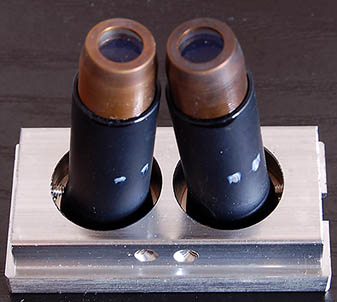
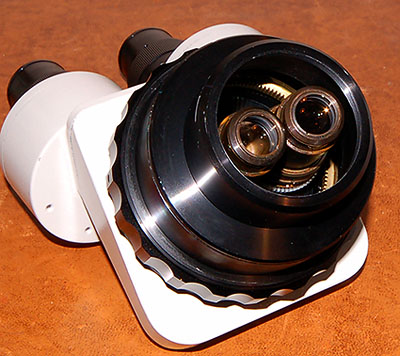
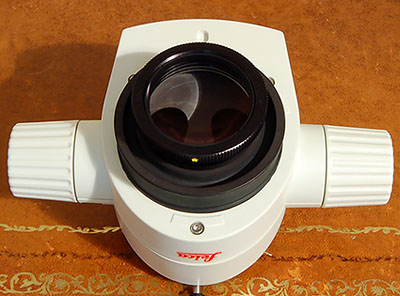
Objective designs of the three stereos.
Left:
Meiji SKC-BT - Paired objectives on sliding mount. Note the three screws centering each
objective. The objectives are not in captive mounts so if trying
to tweak collimation on the stand by loosening and adjusting these screws,
the objectives tend to drop rather than move sideways (the 1x is shown).
Middle: Meiji EMZ-1. A true zoom Greenough design
with each objective mounted in a large factory aligned base. The
zoom mag is activated by a just visible perimeter gear acting on each
objective. Dial in fixed mag models are also common e.g. the EMZ-5.
Accessory objectives can be screwed on front e.g. to half the mag range,
but this is not the same as a CMO design. Note the much larger diameter
of the EMZ-1 13.5 mm cf. the SKC-BT of 7 mm.
Right: Leica MS5. A CMO design. The front main objective (in this case a 1x achromatic) is uppermost. The two ports with the parallel optics for each eye can just be seen. The mag changer is on the side, clickable fixed mag. True zoom designs are also available.
Note on collimation (optical alignment)
The standard of collimation of a stereo needs to be high to ensure fatigue free viewing. Buying new or used from a dealer with guarantees can have benefits cf. e.g an eBay auction although a 'bargain' may be more likely with the latter. A well collimated Greenough should give relaxed viewing but the CMO design is generally noted for being more relaxed for extended viewing because of its parallel optics.
See footnote for a simple but believe accurate collimation check for a Greenough based on a test mentioned in a service manual found online for a Leica SZ7 Greenough stereo.
Assessment
For conciseness, the main features and pros (green) and cons (red) have been itemised in the table below; more important differences observed are discussed in more detail below. Some of these are of course subjective, based on our preferences.
|
Feature |
Meiji SKC - budget paired Greenough |
Meiji EMZ-1 - lab zoom Greenough |
Leica MS5 - lab CMO, click zoom |
|
Build |
Well
built, metal rack and pinion. |
Superb
traditional engineering. |
Sturdy metal in key areas, although plastic rack and pinion with long term uncertain wear properties. |
|
Lighting |
Built-in
lighting models convenient. |
(PBH stand). Incident on axis convenient and good. Transmitted base lighting OK, but uneven. |
(Stand supplied.) Incident on boom convenient but can interfere with focussing and subject manipulation. Larger footprint with external PSU. |
|
Collimation |
Can be variable between objectives in this price range. |
Objectives factory aligned in base. Superior in this price bracket. |
CMO and parallel optics. |
|
Image quality |
Quite crisp, but noticeably duller and lower contrast cf. higher NA objective models. |
Markedly superior to SKC, brighter, crisper more contrasty images. No visible CA. |
(For 1x achromatic CMO). Markedly superior to SKC, brighter than EMZ-1 and also slightly crisper and comparably contrasty images. Marked chromatic aberration on high contrast subjects in transmitted light. |
|
Ergonomics |
Too low on a table for adults, need support to bring up to eye height. |
Height correct for relaxed viewing. |
Height correct for relaxed viewing. |
|
Artefacts of objective design* |
Distortions associated with angled objectives, the so-called 'keystone' effect. |
Distortions associated with angled objectives, the 'keystone' effect. |
Distortions associated with CMO objectives, a so-called 'domed' effect for flat subject. |
*See Nikon MicroscopyU article for illustrated explanation of these artefacts.
Specific Comments
Meiji SKC compared with Meiji EMZ-1
The improvement in image quality between the SKC and EMZ-1 was quite striking (see blowfly image below). The objectives on the budget SKC are 7 mm in diameter cf the EMZ-1 ca. 13.5 mm. Meiji don't mention objective NAs but by calculation the NAs were estimated to be 0.022 for the SKC and 0.075 for the EMZ-1. The over threefold increase in NA* is evident in the much brighter, more contrasty and crisper views from the EMZ-1. Moving back to the SKC it's as if a veil or fog has been brought across the image field (the optics are clean). Although the 2x as supplied objective was well collimated, the Meiji 1x was noticeably strained to use. Update Dec. 2011. *Although the improved performance of the Meiji EMZ-1 may in part be related to increased NA, the author now realises that the measured or single NA quoted for a zoom optics is at the maximum mag end, the NA proportionately decreases with zoom so will be much lower than 0.075 at the lower zoom end. The NA across the zoom range of a stereo optic is almost never stated, so not possible to directly compare the NAs of the two Meiji models or with the Leica MS5.
Meiji EMZ-1 compared with Leica MS5
Optical quality: In some respects the image quality differences were less obvious between these two. The MS5 was noticeably brighter with same transmitted light source (ca. 1.5 stops on a camera, this may partly be because of the wider field eyepiece design) and slightly crisper imaging; the more subtle differences may be expected as they both have similar NA, Leica MS5 with 1x achromatic is quoted as 0.075, the Meiji's calculated with 1X to be also ca. 0.075. Dec. 11 update: See above update on stereo NAs. The MS5 and Meiji EMZ1 NAs cannot be directly compared as the maker's do not provide details on how it varies with zoom. The modern optics and the fixed mag positions of the Leica probably contribute to the edge in image quality (perhaps akin to a prime lens on a camera cf a zoom).
Nikon's MicroscopyU article mentioned above, discusses the difficulties of chromatic aberration control in the CMO design where the edge of a lens is used (the Greenough uses the optical axis of each objective). Certainly with the MS5 at higher mags with high contrast subjects in transmitted light with the 1x achromatic lens, the residual chromatic aberration on the edges of subjects was quite marked, a camera picks it up readily, see example below. Noticeable yellow colour fringes were seen on a subject towards the lens axis and mauve on outer edge of subject. I don't have another comparable CMO stereo to compare the MS5 with to see if it's typical for achromatic CMOs, but the MS5 example was 'as new' and optics clean and bright. Leica's 1x apochromat objective may well excel in this respect in aberration control as well as a higher NA, but believe this objective alone is typically ca. £1000 new.
For incident light work, the residual aberration wasn't noticed on the Leica, with both the Meiji and Leica giving excellent imaging with the edge going to Leica.
Despite the bright optics the move from 2.5x to 4x gives a noticeably duller image on the MS5 and also on the 3x setting on the Meiji. Much of the time using the 1x to 2.5x setting was preferred for the brighter crisper image.
Ergonomics: The high eyepoint eyepieces on the Leica are superb, the best I've used as a spectacle wearer. The Meiji's as-supplied widefield eyepieces had a low eyepoint and unusable with specs (high eyepoint eyepieces are available).
Although the Meiji EMZ-1 was well collimated, the subjective relaxation of the Leica's parallel optics CMO design cf the Meiji's Greenough design was noticeable for extended viewing. We both preferred the side click stop fixed mag compared with the barrel zoom changer on the Meiji (Meiji do have a range of click stop mag models e.g. the EMZ-5).
Build: For those who enjoy traditional engineering build and feel, the Meiji excels, its build was very impressive, no plastic here. The modern Leica MS5, like other makers, now use extensive plastic for some parts but metal in most of the important places. It still has a weighty robust feel but the rack and pinion on the Leica was a wide plastic one. Whether this will stand the test of time cf. metal gearing is unclear. There was a little lateral flex in the optical axis when focussing on the Leica possibly due to the plastic gearing and lack of the traditional metal dovetail focus fittings found on the Meiji.
Lighting: There's many variants for both the Meiji and Leica to suit the user, but 'as supplied' we much preferred the on-axis incident light of the Meiji compared to the rather clunky lamp on a boom for the Leica. The latter offers more modeling opportunities but can get in the way of focussing and subject manipulation, also a larger footprint with the external power supply. The Meiji built-in base lamp, like many stereos, is so-so with two heavy diffusers required for passable even lighting for visual but not for photo work. The light panel remarked on in last month's Micscape suits both the Leica and Meiji stands for superior visual and photo work.
Casual photo work: Trinocular head models are available in the Meiji EMZ range (but an option that needs to be decided on purchase), whereas there's an add-on photo tube for the MS5. These both take images from one eyepiece optical train which although convenient, supporting a camera to an eyepiece should suffice for casual photo work. A small lens digicam like the Sony P200 (similar to W7) supported on the Meiji eyepiece worked very well. The very high eyepoint of the Leica made this trickier, requiring a support to hold it away from eyepiece. The correction for the angled view required for some subjects with a Greenough, see image top of article, isn't required for the MS5.
Images: Mechanical supporting of the camera proved tricky in a domestic environment so are handheld unless stated otherwise, i.e. image sharpness can't be compared. The images were resized with 'high sharpness' setting using Fred Miranda's resizing algorithm. Also slight colour cast correction. No tonal balance changes. All transmitted light images used the same fluorescent light panel.
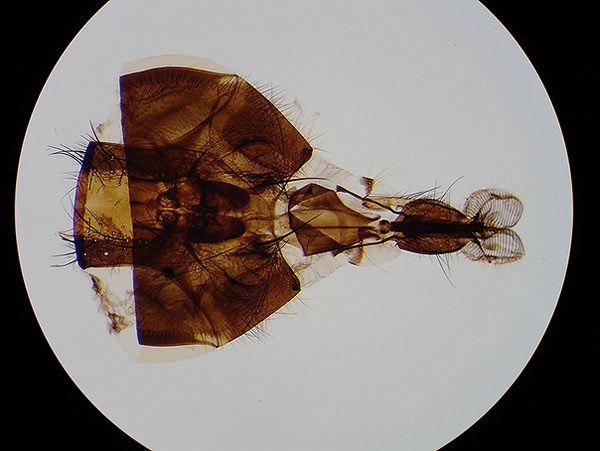
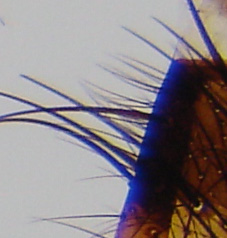
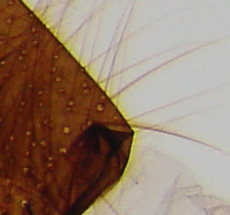
Above:
Leica MS5, 2.6x blowfly larva. Full eyepiece field. Made by author on NBS slide-making
course. 1/50th f2.8 handheld, Sony P200 handheld to eyepiece.
Lower images
are crops from master.
Images
resized for a Web
page are good but in transmitted light with high contrast subjects, the
visible chromatic aberrations seen visually are picked
up by the camera;
blue-mauve and yellow fringing. (This isn't camera sensor blooming). In the
CMO stereo design the edges of the objective are being used where residual aberration
for an achromatic objective can be noticeable. (From inspection the very edge
of the CMO is being used.)
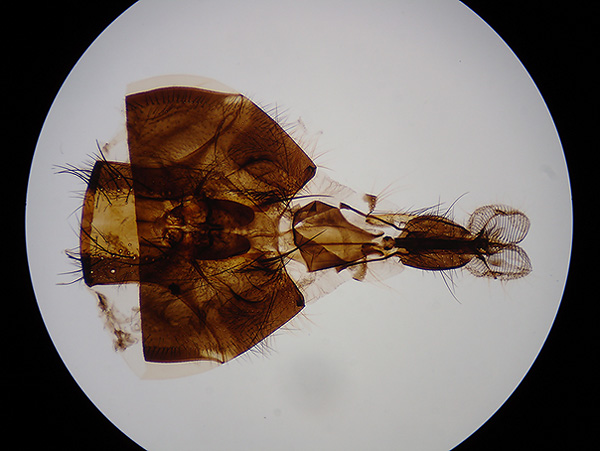
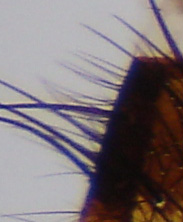
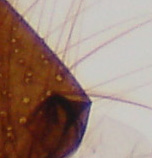
Above:
Meiji EMZ-1, 2.6x blowfly larva. Full eyepiece field. NBS slide. 1/20th f2.8
handheld, Sony P200 handheld to eyepiece.
Lower images are crops from master.
A
little chromatic aberration; in the Greenough stereo design the objectives'
optical axes are being used.
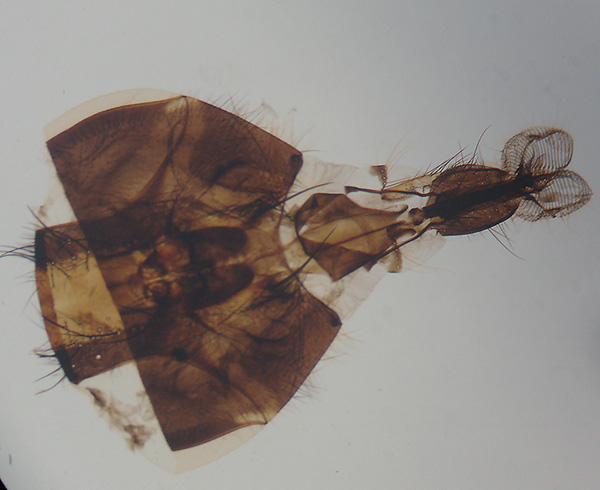
Above:
Meiji SKC for comparison, 2x objective. Supported on tripod over 1x eyepiece.
Note the muddy flattened contrast, dull colours and lack of bite
compared
with the two models above.
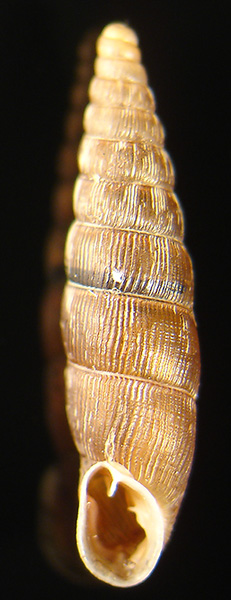
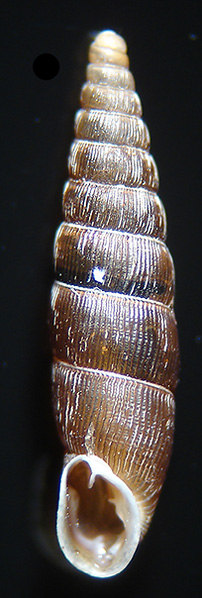
Left
- Leica MS5 with Leica boom lamp on the righthand side.
Right -
Meiji EMZ-1 with built in lamp on PBH stand above shell. Both set to 1x mag.
The
colour balance differs out of camera due to lamp colour temp differences but
an indication of typical incident light image quality.
Mollusc kindly supplied
by Helmut Nisters.
Below Meiji EMZ-1 2x. Water gnat, Victorian slide mounted by A N Tabor (dated 1894). The benefit of a 5° wedge when taking a photo of a flat subject that fills field with a Greenough stereo. First image, no wedge, focussed at centre. The far left and right parts of image are out of the focus plane (much more marked in master image). Lower image with 5° wedge corrects for this. (6 mm sliver of mouse mat on one edge of 3 inch microscope slide; the height required will of course vary depending on slide length.)
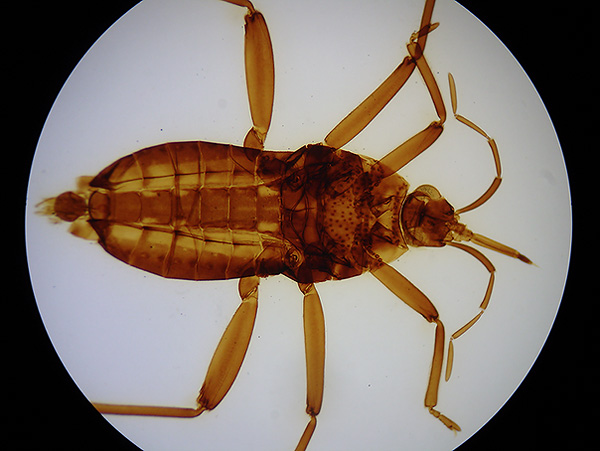
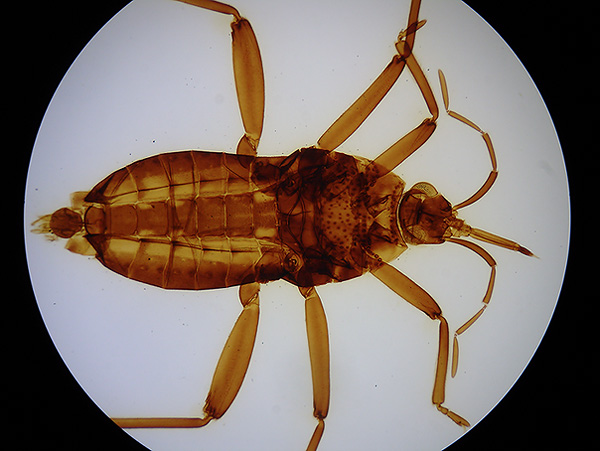
Tentative Conclusions:
The traditional budget Greenough stereo like a Meiji SKC is a good buy for the enthusiast doing casual stereo observations. If the author's example is typical, care needs to be made in checking the standard of collimation of the paired objectives even from big name makers like Meiji; the many clones may need particular care as would used examples. Having now seen what mid priced lab stereos are capable of, it's well worth saving up for a better model if extensive stereo work is planned
The higher grade Greenoughs such as the Meiji EMZ-1 are likely to offer superior image quality because of their brighter, crisper, and likely higher NA objectives and the standard of collimation is likely to be better. Their good working height and superior lighting is also a bonus.
For relaxed extended viewing, the benefit of a CMO design like a Leica MS5 is a benefit.
Overall the Leica MS5 and Meiji EMZ-1 were enjoyable scopes to use and gave excellent images; for the models variants as supplied, both my brother and I had a slight preference for the Meiji EMZ-1 for its traditional engineering feel, convenient on-axis top lighting (with PBH stand) and better aberration control in transmitted light with achro' objectives supplied, both visually and for photo work. We don't have access to a Leica CMO apo but suspect would put the MS5 in a different league (optically and used price bracket) to the EMZ-1.
Comments to the compilers David and Ian Walker are welcomed.
Footnote on collimation (subjective opinions from hands-on experiences rather than any claim to have a service engineer's knowledge!)
It
can be useful to check a Greenough objective collimation as an exercise
(assuming bino head OK). Like others, I've tried concentric rings
as a subject in the past but found it hard to quantify. But I recently stumbled
upon a service manual online courtesy
of Reichert Microscope Services for a Leica SZ7 (Greenough stereo) which described a technique
for assessing some aspects of optical alignment. The test below is based on
this.
1) The dioptre settings of the stereo eyepieces are accurately set
up for the user's eyes and also parfocality if a zoom design (consult maker's
manual for procedure).
2) A micrometer is placed in one stereo eyepiece (if
a wide reticle isn't available for a stereo eyepiece, a simple mount for
one from a compound microscope can be made). (The Leica manual used a cross
hair in the eyepiece, but I think a micrometer reticle is better as allows any
misalignment to be quantified.)
3) A crisply delineated subject is
placed on the stage and focussed accurately with left eye, I use a LOMO centering
slide for a rotating stage with cross hair and circle. It should be aligned
as near as possible the field centre and aligned with a known part of reticle.
It's not vital to be at the exact field centre as long as slide doesn't
move (best taped in position).
4) Then place this eyepiece reticle in the
righthand tube and use right eye to check if it's in same position
(if it's not sharp without changing focus, step 1 was done incorrectly).
This
test is using the principle that at or very near the optic axis of each
objective, the subject should match to within a high tolerance in each
eyepiece. I'm uncertain though as to how much out of alignment is regarded
as acceptable.
I tried this for a Meiji 2x which I found relaxed and a third party 2x one bought new off eBay which found subjectively very strained. The results below confirm the subjective appraisal.
|
|
|
Third party new 2x objective bought off eBay. Aligned on '55' in left eyepiece. Note the considerable shift when viewed in the right i.e. the eyes are not being presented the same point in subject at or near optical axis centre. This objective was noticeably strained to use. (The shift corresponded to 5 mm on the stage.) |
Published in the March 2007 edition of Micscape.
Please report any Web problems or offer general comments to the Micscape Editor .
Micscape is the on-line monthly magazine of the Microscopy UK web site at Microscopy-UK
© Onview.net Ltd, Microscopy-UK, and all contributors 1995
onwards. All rights reserved.
Main site is
at www.microscopy-uk.org.uk
with full mirror
at www.microscopy-uk.net
.